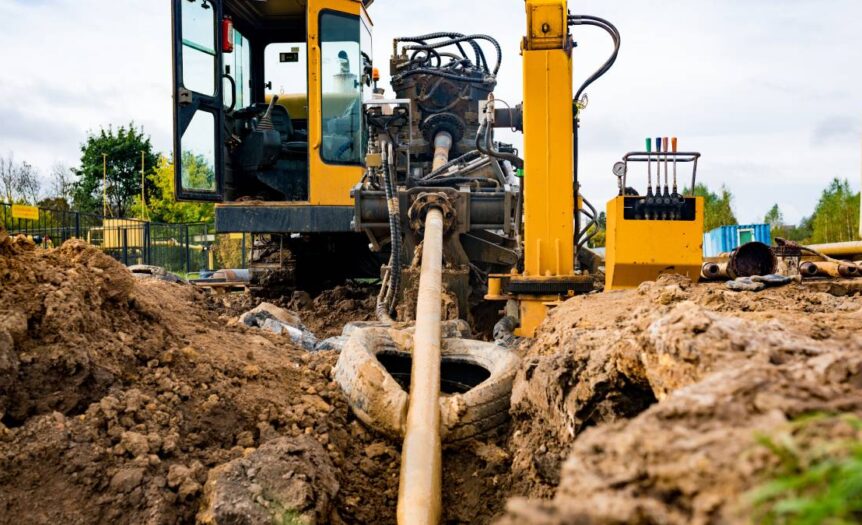Horizontal directional drilling (HDD) is a minimal-impact trenchless construction method, allowing for the installation of underground pipes, conduits, and cables using a surface-launched drilling rig. It brings a revolutionary approach to laying infrastructure with minimal disturbance to the surrounding area. Explore more about what to know about horizontal directional drilling below.
How Horizontal Directional Drilling Works
The process works by first drilling a pilot hole along a predefined path from one surface point to another. Then, the drilled hole gets enlarged until it can accommodate the pipeline or conduit.
Finally, a team pulls the pipe through the hole, ensuring a seamless installation beneath obstacles like rivers, buildings, and roads. This is usually done with pipe rollers, stands, and side booms, but cranes can also assist, such as in this San Antonio water pipeline project.
Overall, the technique is less invasive than traditional trench digging, offering a relatively easy method of laying pipes and cables.
Its Benefits
There are many benefits of horizontal directional drilling. Firstly, it drastically reduces environmental impact, preserving the landscape and protecting local ecosystems from the extensive damage of traditional excavation.
Additionally, HDD minimizes disruption to traffic and businesses, a significant advantage in urban areas where stopping the flow of life could cause chaos.
Furthermore, it often proves to be more cost-effective in the long run, with decreased labor costs and faster completion times.
The Challenges It Poses
Despite its advantages, horizontal directional drilling comes with its own set of challenges. The process requires precise planning and execution—miscalculations can lead to costly mistakes or project delays.
Furthermore, dealing with underground utilities poses a significant risk; accidentally striking existing pipelines or cables can lead to service disruptions and safety hazards.
Lastly, the initial investment in specialized equipment and skilled labor may be higher than for traditional methods. However, this is usually offset by the overall benefits.
Concluding Thoughts
Horizontal directional drilling weaves through the underground with minimal surface disruption, offering an elegant solution to a complex problem. Now that you’ve learned the key parts of what to know about this technique, you can appreciate its value.










 Deering Estate
Deering Estate
 Massage Envy South Miami
Massage Envy South Miami
 Calla Blow Dry
Calla Blow Dry
 My Derma Clinic
My Derma Clinic
 Sushi Maki
Sushi Maki
 Sports Grill
Sports Grill
 The Healthy Kitchen
The Healthy Kitchen
 Golden Rule Seafood
Golden Rule Seafood
 Malanga Cuban Café
Malanga Cuban Café

 Kathleen Ballard
Kathleen Ballard
 Panter, Panter & Sampedro
Panter, Panter & Sampedro
 Vintage Liquors
Vintage Liquors
 The Dog from Ipanema
The Dog from Ipanema
 Rubinstein Family Chiropractic
Rubinstein Family Chiropractic
 Your Pet’s Best
Your Pet’s Best
 Indigo Republic
Indigo Republic




 ATR Luxury Homes
ATR Luxury Homes


 2112 Design Studio
2112 Design Studio
 Hamilton Fox & Company
Hamilton Fox & Company
 Creative Design Services
Creative Design Services
 Best Pest Professionals
Best Pest Professionals
 HD Tree Services
HD Tree Services
 Trinity Air Conditioning Company
Trinity Air Conditioning Company
 Cisca Construction & Development
Cisca Construction & Development
 Mosquito Joe
Mosquito Joe
 Cutler Bay Solar Solutions
Cutler Bay Solar Solutions


 Miami Royal Ballet & Dance
Miami Royal Ballet & Dance
 Christopher Columbus
Christopher Columbus
 Pineview Preschools
Pineview Preschools
 Westminster
Westminster
 Carrollton
Carrollton
 Lil’ Jungle
Lil’ Jungle
 Frost Science Museum
Frost Science Museum
 Palmer Trinity School
Palmer Trinity School
 South Florida Music
South Florida Music
 Pinecrest Orthodontics
Pinecrest Orthodontics
 Dr. Bob Pediatric Dentist
Dr. Bob Pediatric Dentist
 d.pediatrics
d.pediatrics
 South Miami Women’s Health
South Miami Women’s Health

 The Spot Barbershop
The Spot Barbershop
 My Derma Clinic
My Derma Clinic




 Miami Dance Project
Miami Dance Project

 Rubinstein Family Chiropractic
Rubinstein Family Chiropractic
 Indigo Republic
Indigo Republic

 Safes Universe
Safes Universe
 Vintage Liquors
Vintage Liquors
 Evenings Delight
Evenings Delight





 Atchana’s Homegrown Thai
Atchana’s Homegrown Thai
 Baptist Health South Florida
Baptist Health South Florida

 Laser Eye Center of Miami
Laser Eye Center of Miami
 Visiting Angels
Visiting Angels
 OpusCare of South Florida
OpusCare of South Florida

 Your Pet’s Best
Your Pet’s Best





 HD Tree Services
HD Tree Services
 Hamilton Fox & Company
Hamilton Fox & Company


 Creative Design Services
Creative Design Services